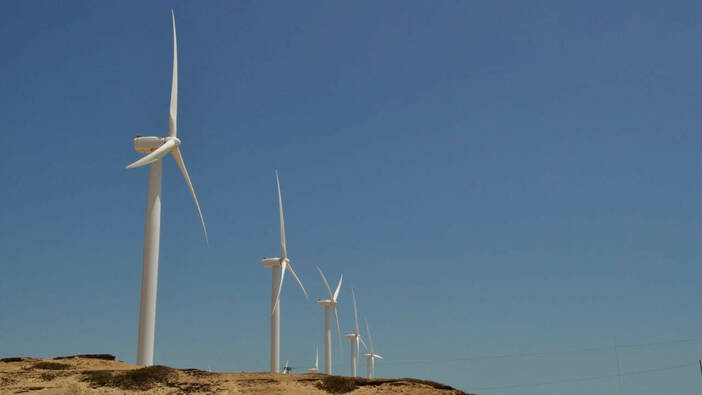![Lucio Cuenca Berger [Translate to en:] Lucio Cuenca Berger](/fileadmin/_processed_/1/8/csm_Foto_Miguel_Hechenleiner_7398614362.jpg)
Chile is one of the few countries in the world, and the only nation in Latin America, to have adopted a “National Green Hydrogen Strategy”. The country is also one of the global leaders in pilot projects for producing green hydrogen fuel. The ever-growing interest surrounding the production and export of green hydrogen is facilitated by, among others, Germany, in cooperation with the Chilean Ministry of Energy and the Corporación de Fomento y Producción (CORFO), a collaboration that is also linked to research projects on the transportation of large-scale ore, within a framework of making the mining of minerals like lithium and copper “green”.
Lucio Cuenca Berger is an engineer at the University of Santiago de Chile (Usach) and director of the Observatorio Latinoamericano de Conflictos Ambientales (OLCA), which works with the Rosa Luxemburg Foundation.
To understand the progress of energy projects in Chile, especially surrounding green hydrogen and its socio-environmental impacts, and possibilities for a shift in the extractive model within the political context of the ongoing constitutional process, Elisangela Soldateli Paim of the Rosa Luxemburg Foundation’s climate programme spoke with Lucio Cuenca Berger, an engineer at the University of Santiago de Chile (Usach) and director of the Observatorio Latinoamericano de Conflictos Ambientales (OLCA), one of the foundation’s partner organizations in the region. Lucio was also a candidate to the constitutional convention for Red No Alto Maipo and the Movimiento por el Agua y los Territorios in Santiago de Chile.
What is the backdrop against which Chile’s green hydrogen energy policy is unfolding?
In his annual speech to congress, delivered to the nation in July 2020, President Sebastián Piñera said, “Chile can become an energy-exporting power, particularly with view to the promising prospects offered by green hydrogen, which can become a more powerful source of development and exportation than mining in our country.” This marked the first time that a high-level government authority made the role and the commitment to green hydrogen in energy and exporting policy explicit.
Chile is the first Latin American country to adopt a national strategy for green hydrogen, issued by the Ministry of Energy in November 2020. Although it is said that this strategy was the result of collaboration between companies, academia, civil society, and the public sector, in fact those involved came mainly from the energy and extractivism sectors. There was no public consultation on the subject. Green hydrogen is still in its infancy. Pilot and demonstration projects are still in the development phase. Two projects are currently being developed and there is a call for new projects.
Hydrogen itself is not an energy source, but an energy carrier. Electricity must be used for its production, the splitting of water into its components (electrolysis). Hydrogen is described as “green” if it is produced with the help of renewable energies. On this basis, the energy transition is to be extended to the transport, industrial, and heating sectors.
International organizations have been creating conditions and justifications for this strategy’s prioritization in Chile. Take, for example, the International Energy Agency, which stated that Chile had the conditions to produce green hydrogen with the lowest costs in the world. On the other hand, the World Energy Council of Germany, while referring to the potential for the production of renewable energy, dubbed the country a “Hidden Champion” in its 2018 report. It is interesting to note that, as early as 2017, the Washington Post referred to Chile as “the Saudi Arabia of renewables”, hinting at the resemblance between Chile’s potential for renewable energy and the crude oil exports of Saudi Arabia. The production of green hydrogen through electrolysis requires electrical energy from renewable sources, for which Chile has more potential than anywhere else in the world.
The interest in green hydrogen is promoted by, among others, Germany. The German Corporation for International Cooperation (GIZ) on behalf of the Ministry of the Environment initiated a collaboration with the Chilean Ministry of Energy and the Corporation for Development and Production especially focused on mining. Since 2017, two co-funded research projects are being developed in large-scale mining. The GIZ was also instrumental in organizing the first international seminars on hydrogen in Chile, which were held in May 2017 and September 2018, drawing the attention of key figures in government, industry, and academia.
The Ministry of Energy, with support from the GIZ and various national and international organizations, is working on an official regulatory framework for the hydrogen market. A relevant outcome of this process was the creation of the Chilean Hydrogen Association, H2 Chile, in January 2018, for the purposes of promoting hydrogen production in Chile and accelerating the energy transition hand in hand with the production and exportation of green hydrogen.[1]
Chile’s installed capacity for electricity generation surpasses its demand by two-fold. Moreover, the country is reaching an installed capacity of 20 percent in renewable energy. A transition to decarbonize the matrix could be initiated right now, without substantial impacts on the lives of the peoples and even without many debatable extractive economic activities. In that light, it is clear that green hydrogen is not part of a strategy of decarbonization and energy transition for Chile proper.
Who are the main players involved in the plans to produce and export hydrogen from Chile?
In the Chilean case, transnational corporate interests and pro-export extractivist neoliberal policies are closely aligned. Most of the public-private interests on green hydrogen are grouped, today, in the Chilean Hydrogen Association, H2 Chile. According to its president “Chile can play an important role in, for instance, helping Germany to achieve its energy transition goals.” That hints at the fact that some countries are tailoring their decarbonization strategies to the production of green hydrogen in places such as Chile. If we look closer, we see that Chilean companies such as Enaex, Enap, Andes Mining and Energy, and Colbún, and transnational companies such as the French Engie, Enel Green Power from Italy, and Siemens Energy from Germany are behind it.
At the same time, there is great interest from the mining sector in tying its anticipated expansion to green hydrogen. This serves two purposes: on the one hand, to elude the profound challenges that exist with regard to mining’s social and environmental impact, while creating an image of a more “competitive” and “sustainable” mining, while on the other hand, to generate “added value” while obtaining better prices with “green copper”. Furthermore, it is necessary to mention that the sector of non-conventional and renewable energy also bets on the expansion of large-scale wind and solar projects hand -in-hand with the production of green hydrogen.
The figures on which this incipient new extractivist business is based are related to the amount of green hydrogen that can be produced in Chile. Based on its potential for renewable energy, our country could produce about 200 megatons of green hydrogen per year. That would be around three times the current annual global production of hydrogen, which is nearly 70 megatons. This potential justifies the expansion of extractivist production of green hydrogen in Chile.
What are the socio-environmental impacts generated or intensified by the possible growth of green hydrogen production in Chile?
The northern regions of Chile, particularly the Atacama desert, where the potential for solar energy to power the production of green hydrogen is currently being investigated, are heavily impacted by mining. In particular, this includes the overexploitation and contamination of water, contamination of the air in cities, but also the sacrifice zones in coastal areas where coal-fired thermoelectric plants, mining foundries, and mining transportation services operate. On the other hand, in the Magellanic Patagonia, where wind energy potentials have been identified, despite there being water in greater abundance compared to northern Chile, the ecosystems are much more fragile and the climatic conditions for human life much more extreme.
In the discussions around green hydrogen, there is a tendency not to speak of the water used and its impacts, of the territorial impacts due to desalination or the installation of gigantic wind or solar energy plants. But this strategy to make mining “green” also serves the purposes of increasing the extraction of copper and lithium, now “green” as well, without considering the impacts—territorial, social, and on the indigenous peoples.
Therefore, green hydrogen is posed as the great solution to achieve decarbonization, but irrespective of the local impacts that it will generate or aggravate. Ultimately, the countries of the Global South are to be the ones to sustain, at the expense of the well-being of the communities and their territories, the so-called “energy transition”.
What are the prospects for a possible change in the energy model with the current political situation in Chile, especially with regard to the ongoing Constitutional Convention?
The constitutional process has fostered profound questions concerning Chile’s energy model. It is necessary to build the social right to energy, within the framework of a paradigm other than the one we have today, and to challenge the false solutions posed to us in the face of the climate crisis.
Today, Chile is facing an unprecedented social, political, economic, and health crisis. In the face of that, the government has proposed an economic reactivation plan that entails an advance in extractivism, facilitating the implementation of several projects, mainly in the energy sector.
Therefore, in the constitutional debate, it is fundamental for us to face the ecological and social crisis as a whole. For that, it is necessary to end the subsidiary state and the privatization of nature, to move towards a multinational state, while constitutionally acknowledging indigenous people. This means acknowledging that nature is also a subject of rights, valuing the life of local communities and ecosystems, and laying the foundations to move towards a post-extractivist energy transition.
What alternative proposals have emerged to counteract the imposition of extractivist models, both in social and ecological terms?
Today, in Chile, we are in the middle of a constitutional process that entails a deep questioning of the current model. But this process began much earlier, with the territorial and social-environmental challenges and struggles, from which it is possible to address transversal issues such as the deprivatization of water, the right to ecological restoration, the management of community water, the rights of nature, and the rights of indigenous populations.
The organized communities have raised fundamental questions about the extractivist projects and led fierce fights to defend their territories. Today, in the context of the constitutional process, various candidates have been nominated to represent of the communities at the Constitutional Convention, and thus to include the historical demands of the territories, such as the human right to water and its community management, in a new constitution, to acknowledge nature as a subject of rights, and to advance towards the self-determination of the peoples.
[1] The partnering companies include Austria Energy, Aes Gener, TCI Gecomp, Colbun, FRV, Cummins Chile, Enagas, Sumitomo Corporation (Chile) Limitada, Engie, Busso Group, Siemens Energy (Germany), ABB, Grupo Energy Lancuyen, Pronor Green Energy, Enel Green Power, Prime Energía, Enex, Antofagasta Minerals, IVM (attorneys at law), Solek, Interenergy, Tractebel Engie, RWE, Teching (engineering and construction), Antuko, Andes Solar, COPEC, Air Liquide, and SPHERD Energy.


